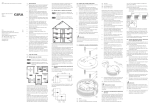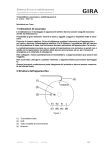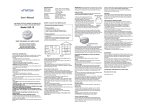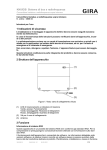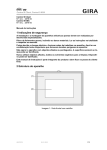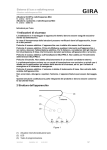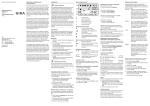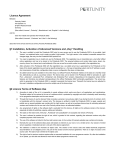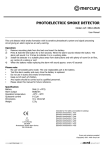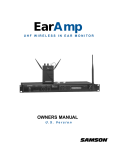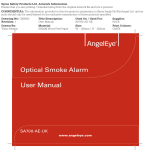Download Mise en page 1
Transcript
FITT-10210 Issue 1 Product features • Battery-operated, combined smoke alarm device and thermal detector (maximum and differential function) for the protection of residential buildings, apartments or rooms with similar purpose in accordance with DIN 14676 • Smoke detection can be disabled for rooms where the ambient conditions are not favourable for the smoke alarm device, such as kitchens (vapour from cooking) • Automatic selftest of smoke evaluation with impurities indicator • When dark, up to 12 hours delayed indication of battery replacement display or technical fault • Wired networking of up to 40 smoke detectors • Loud, intermittent warning tone, minimum 85 dB (A) • Battery replacement display • Soiling/fault display • Built-in button for function test • Battery compartment interlock: if the smoke detector does not have a battery fitted, then it is not possible to lock it into place in the mounting plate or 230 V base. • 1 module interface for fitting one of the optionally available modules; the network terminals remain available for use • Polarity reversal protection: The unit cannot be destroyed due to incorrect battery connection • Can be retrofitted with 230 V base for Smoke alarm device Dual/VdS (product no. 2331 02) 25 GB 1 Installation location 2.1 Example for an apartment GB 2 Minimum protection: one smoke alarm device in the corridor or stairwell. Optimum protection: one smoke alarm device in each bedroom and living room. Smoke detectors should ideally be installed in front of or inside bedrooms, so that the occupants will be woken up if there is a fire at night. For optimum performance, install the smoke alarm device in the middle of the room under the ceiling. If this is not possible, observe a minimum distance of 50 cm to the walls. The smoke detector can monitor rooms with a floor area up to a maximum of 60 m2 and a maximum height of 4.5 m. In rooms with unfavourable conditions for smoke alarm devices, such as kitchens (vapour from cooking), bathrooms (condensation), garages or very dusty areas, smoke detection can be disabled in order to avoid false alarms (Section 3.2). In this case, only the thermal function will remain active. 26 Example for a residential building Minimum protection: one smoke alarm device in the corridor or stairwell of each floor. Optimum protection: one smoke alarm device in each bedroom, living room and basement room. In buildings with several storeys, install at least one smoke alarm device in the corridor of each storey. Use several networked smoke alarm devices in larger houses in order to cover the entire living area. If smoke is detected by a smoke alarm device, it triggers an alarm and activates all the connected smoke alarm devices which then also emit an alarm. This ensures, for example, that you are woken during the night in your bedroom by your networked smoke alarm device if the smoke alarm device in the basement detects smoke. The same requirements apply to the installation of individual smoke alarm devices in rooms and the use of the thermal detection function as those described for installation in an apartment (Section 2.1). 27 GB 2.2 2.3 Examples for particular room geometries GB In L-shaped rooms or corridors the smoke alarm devices should be installed on the centred intersections of the two sections. In the case of large L-shaped rooms, each section is regarded as a separate room. 28 2.4 Unsuitable installation locations In order to avoid false alarms, do not install the smoke alarm device: GB • with active smoke detection in rooms in which a lot of steam, dust or smoke occur under normal conditions (Section 3.2) • near fireplaces or open fires • directly on a metal surface • less than 1 m away from air conditioning units and ventilation shafts, as the air flow may prevent the smoke and/or heat from reaching the alarm • at least 50 cm away from electrical ballasts, low voltage transformers, fluorescent lights and energy saving lights • in rooms which are higher than 4.5 m • less than 30 cm away from the roof apex • only in rooms where the temperature does not fall below -5 °C or rise above +50 °C • less than 6 m away from hot-air vents Attention Do not mount the smoke alarm device in a vertical position on a wall. This can cause it to malfunction. 29 3 Installation and commissioning GB 1 2 3 4 5 6 7 30 Depending on the design, the smoke detector will be fitted using a mounting plate (only for battery operation) or an optional 230 V base (battery as backup power). If using a 230 V base, please follow the instructions in the corresponding Installation and User Manual. 1) Before attaching the mounting plate, cut out the prepunched slot for the cable feed using a suitable knife. 2) Mount the mounting plate with the enclosed mounting material. 1 Dowel 2 Mounting plate 3 Cable slot (pre-punched) 4 Screws 5 Module interface 6 Block battery (9 V) 7 Smoke alarm device 3) Use the spacers if the cable for networking several smoke alarm devices has to be surface-laid (Gira Product Number 2342 00). 4) If necessary, network several smoke alarm devices (Section 3.1). GB 5) If appropriate, disable smoke detection (Section 3.2). 6) Insert a radio or relay module if required (see corresponding Installation and User Manual). 7) Connect the 9 V battery to the battery connection and insert the battery in the battery compartment. 8) To prevent unauthorised removal of the smoke alarm device, if necessary activate removal protection to lock the smoke alarm device on the mounting plate. To do this, cut out the prepunched slot on the alarm housing using a suitable knife (see figure). The locking mechanism can now only be opened using a suitable tool. 31 9) Insert the smoke alarm device into the mounting plate and secure it by turning it clockwise slightly. GB 10) Carry out a function test. Insert battery The alarm cannot be secured on the mounting plate or base unless the battery is inserted. 3.1 Wired networking of smoke alarm devices Up to 40 Gira Dual/VdS smoke detectors can be connected together in a network to allow an alarm to be sounded by all the smoke detectors in a dwelling. Connect the smoke alarm devices in parallel with a twoconductor cable (e.g., phone cable: J-Y(St)Y 2 x 2 x 0.6 mm). When a maximum wire cross-section of 1.5 mm2 is used, the total cable length can be up to 400 m. To network the smoke alarm devices, proceed as follows: 1) Connect the 3-pin terminal block to the cable as shown in the figure. N Signal N Detector 1 32 N Detector 2 N Detector n 2) Insert the terminal block in the corresponding holder in the mounting plate. For wired networks where the 230 V base is used, please refer to the corresponding Installation and User Manual. 3.2 GB It is not possible to create a wired network with modular/VdS smoke detectors. Thermal detector function/deactivating the smoke detector The thermal detector operates on the temperature rise principle and triggers an alarm if: • the rate of heating of the surrounding air exceeds the normal range, • the temperature of the surroundings reaches a value between 54 °C and 70 °C. Because it is possible to deactivate smoke detection on the Dual/VdS smoke detectors, they are also suitable for installation in areas where conventional smoke detectors cannot be used. • in rooms where smoke detection is not appropriate, such as kitchens (steam from cooking) and bathrooms (condensation), • rooms where there is a lot of dust (e.g. garages). In such cases, it can make sense to deactivate the smoke detection in order to avoid false alarms. In such cases the smoke detector will only function as a thermal detector. Proceed as follows to deactivate smoke detection (deactivation is not permitted while an alarm is ongoing): 1) If necessary, remove the battery as the slide switch is located on the PCB under the battery compartment. 2) Break out the cover over the slide switch using a suitable tool. 33 GB Attention Breaking out the slide switch cover will invalidate the CE conformity of the smoke detector in accordance with EN14604 and invalidate the German Association of Property Insurers (VdS) Approval. 3) Set both slide switches to the “ON” position (see figure) to deactivate smoke detection. 4) Reconnect the 9 V block battery to the battery connector and insert the battery into the battery holder. 5) Carry out a function test (Section 7). 34 4 Operating and alarm signals Acoustic signal Loud intermittent signal 85 dB(A) 8 short signals in 60-sec. cycle 2 short signals in 60-sec. cycle 1-sec. continuous signal 73 dB(A) 1-sec. continuous signal 73 dB(A) Light ring Flashes rapidly Flashes 8x in 8-sec. cycle Flashes 1x in 5-sec. cycle Continously on (previous event was an alarm) Flashes rapidly (previous event was not an alarm) If using the 230 V base, please follow the instructions in the corresponding Installation and User Manual. Different signals are used to indicate “Fault”, “Soiling”, and “Battery change due”. Meaning Local alarm Smoke or heat Fault/soiling - Cannot be deactivated Battery change due (local) Function test (local), activated by pressing the function button for at least 4 s (Section 7) Function test (local), activated by pressing the function button for at least 4 s (Section 7) 2 1 1 Light ring 2 Function button 35 GB General GB For wired or radio-networked (if equipped with optional radio module) smoke alarm devices The signals generated by the smoke alarm device that triggers the alarm are as described above. The other smoke alarm devices will also emit the following signals: Acoustic signal Loud intermittent signal 85 dB(A) 2 short signals in 60-sec. cycle Light ring - 1-sec. continuous alarm signal 73 dB(A) followed by 2 s pause - 5 - Meaning Alarm at networked smoke detectors - smoke or heat only for wireless networks: Battery change due (remote signal) Function test (remote signal), activated by pressing the function button for at least 4 s (Section 7) Battery test – Changing the battery The smoke detector is powered from a 9 V block battery (if a 230 V base is used, then only when there is an interruption to the mains power). The battery test automatically checks the supply voltage at regular intervals. If the battery voltage drops below a defined level, the smoke alarm device signals for 30 days that the battery has to be replaced. The smoke alarm device is completely functional during this period. 36 To replace the battery, proceed as follows: 1) To do this, release the locking mechanism with a screwdriver and turn the smoke detector anticlockwise. GB 2) Remove the old battery from the compartment and disconnect the connector from the battery connection. 3) Connect the new 9 V battery to the battery connection and insert the battery in the battery compartment. 4) Reinsert the smoke detector into the mounting plate or 230 V base and lock in place by turning gently clockwise. Insert battery The smoke alarm device cannot be secured on the mounting plate or base unless the battery is inserted. 5) Carry out a function test. Only replace the old battery with a new battery of the same type. Dispose of the old battery in an environmentally-friendly way. 37 6 Maintenance and care GB In order to ensure the functional reliability of the smoke alarm device for a longer period, you should carry out maintenance once a month (or immediately when a fault message occurs): 1) Remove the smoke alarm device from the mounting plate (turn counter-clockwise) and remove any dust. 2) Wipe the smoke alarm device with a damp lint-free cloth. 3) Insert the smoke alarm device back into the mounting plate and turn it clockwise until it is secured. 4) Carry out a function test (Section 7). Note Replace the smoke alarm device on the date specified on the device label. If carrying out renovations in the room, the smoke alarm device must be completely covered with the plastic cover supplied. Do not forget to remove the plastic cover again after completing the renovation work! Attention The smoke alarm device must not be painted! 38 7 Function test Carry out the function test once a month and especially after long periods of absence: 1) Press the function button for at least 4 seconds: • If an audible signal is emitted following a short acknowledgement sound and the light ring comes on (Section 4), then the smoke alarm device is operating correctly. • If no signal is emitted, replace the battery. 2) Then carry out the function test again. If a signal is still not emitted, then the smoke detector is faulty and must be replaced. 3) Stop the function test by pressing the function button until the acknowledgement signal is heard. If a function test is carried out on wired or radio-networked smoke alarm devices, all the connected smoke alarm devices emit an acoustic alarm. If this does not occur, please check the batteries of all the smoke alarm devices and the connections and state of the network cables. 39 GB When carrying out a manual test, the smoke alarm device emits a muffled signal. However you should still prewarn neighbours. Stay at least 50 cm away from the smoke alarm device during a function test. 8 Manual suppression of signals 8.1 Suppressing the smoke detection alarm GB Smoke detection can be deactivated for 15 minutes: • as a preventative measure to suppress an unwanted alarm when carrying out activities that generate dust (sweeping a dusty room, sweeping the chimney, etc.), • to shut off the alarm if you detect non-hazardous smoke. To do this, press the function button briefly (< 3 seconds) until a short acknowledgement signal is heard and then muted again. The light ring now flashes every 2 seconds Note Thermal detection is still active. 8.2 Suppressing the event display A photovoltaic cell is used to suppress the “Detection head dirty” and “Battery change due” warnings (Section 4) for up to 12 h during hours of darkness. This has no influence on the alarm functionality provided by the smoke detector. If the “Replace battery” or “Fault/soiling” message occurs at an inopportune time, it can be deferred by 8 hours each day for a maximum of 7 days. To do this, press the function button briefly, until the first signal tone is muted. However, remove the source of the fault as soon as possible. Please contact your installer to rectify cause of the problem. 40 Technical specifications Nominal voltage: 9 V DC Battery: - 9 V block alkaline, type: DURACELL PLUS/6LR61. Lifetime approx. 5 years, with radio module approx. 2 years. - 9 V block lithium, type: ULTRALIFE/U9VL-J. Lifetime approx. 10 years, with radio module approx. 5 years. Battery failure signal: 60-sec. cycle, 30 days Optical indication: Light ring red Acoustic alarm indication: piezo primary detector: Intermittent Volume: Min. 85 dB (A) at 3 m Housing dimensions: 125 x 48 mm (Ø x H) Plastic material: PC+ASA Operating temperature: -5 °C to +50 °C Storage temperature: -20°C to +65°C Weight (without battery): Approx. 120 g Degree of protection: IP42 VdS approval: See rating plate on smoke detector 41 GB 9 10 CE declaration of conformity GB Please note that CE conformance in accordance with EN14604 is only valid if smoke detection is not deactivated (Section 3.2). 09 0786-CPD-20896 VdS approval number: G209202 EN14604:2005 Smoke alarm device Dual/VdS Giersiepen GmbH & Co. KG Dahlienstraße 12 42477 Radevormwald, Germany 42 11 Warranty Please send the unit postage free with a description of the defect to our central customer service via your specialised dealer: Gira Giersiepen GmbH & Co. KG Service Center Dahlienstraße 12 42477 Radevormwald Deutschland 43 GB We provide a warranty as provided for by law.




















